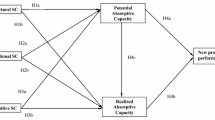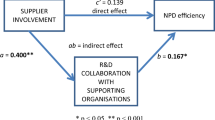Abstract
Do forerunners in global value chains (GVCs) select supplier in knowledge collaboration in a different way from latecomers? There are many factors in the selection criteria in co-creating GVC value and enhancing a focal firm’s competitiveness. However, little has been revealed on how firms select their GVC suppliers from the knowledge embeddedness perspective. Furthermore, latecomers and forerunners have gaps in knowledge that may result in different weights on the same selection elements. Based on the knowledge embeddedness theory, we compare the selection criteria of a latecomer (Huawei) with a forerunner (Apple). Specifically, we identify 129 Apple or Huawei global suppliers in 2018 and collect 144,496 patents of these suppliers. Using the data of patents and the tracking of backward citations from 2013 to 2017, we find that, as a latecomer, Huawei depends more on criteria of structural hole positions in GVC knowledge network, knowledge base, and scientific knowledge than Apple does. We further conduct scenario analysis to understand Huawei’s decoupling possibility from GVCs under tech cold war.


Similar content being viewed by others
Notes
Apple released iPhone5 in 2012 and iPhone 5c/5s in 2013, building a solid market share in mobile phone business. In 2012, Huawei decided to expend its mobile phone business to consumer market. Richard Yu, CEO of Huawei's consumer business group, said in 2016: "When we announced four years ago that we wanted to sell phones, people told us we were crazy. When we said we wanted to sell 100 million phones, they told us we were crazy, we are going to take [Apple] step-by-step, innovation-by-innovation.” Reported by FastCompany Magazine: https://www.fastcompany.com/company/huawei.
Kastrenakes, J. (2019) Apple and Qualcomm drop all lawsuits in surprise settlement, The Verge, Apr 16, 2019, https://www.theverge.com/2019/4/16/18410985/apple-qualcomm-settle-royalty-dispute-patent-licensing-terms-high-fees
References
Ahuja, G. 2000. Collaboration networks, structural holes, and innovation: A longitudinal study. Administrative Science Quarterly, 45(3): 425–455.
Ambos, B., Brandl, K., Perri, A., Scalera, V. G., & Van Assche, A. 2021. The nature of innovation in global value chains. Journal of World Business, 56(4): 101221.
Aretoulis, G. N., Kalfakakou, G. P., & Striagka, F. Z. 2010. Construction material supplier selection under multiple criteria. Operational Research, 10(2): 209–230.
Argyres, N., Bigelow, L., & Nickerson, J. A. 2015. Dominant designs, innovation shocks, and the follower's dilemma. Strategic Management Journal, 36(2): 216–234.
Asakawa, K., Park, Y., Song, J., & Kim, S.-J. 2018. Internal embeddedness, geographic distance, and global knowledge sourcing by overseas subsidiaries. Journal of International Business Studies, 49(6): 743–752.
Autio, E., & Fu, K. 2015. Economic and political institutions and entry into formal and informal entrepreneurship. Asia Pacific Journal of Management, 32(1): 67–94.
Benito, G. R., Petersen, B., & Welch, L. S. 2019. The global value chain and internalization theory. Journal of International Business Studies, 50(8): 1414–1423.
Boone, C., Lokshin, B., Guenter, H., & Belderbos, R. 2019. Top management team nationality diversity, corporate entrepreneurship, and innovation in multinational firms. Strategic Management Journal, 40(2): 277–302.
Borgatti, S. P. 2005. Centrality and network flow. Social Networks, 27(1): 55–71.
Borgatti, S. P., & Halgin, D. S. 2011. On network theory. Organization Science, 22(5): 1168–1181.
Brass, D. J. 1992. Power in organizations: A social network perspective. Research in Politics and Society, 4(1): 295–323.
Buciuni, G., & Pisano, G. 2021. Variety of innovation in global value chains. Journal of World Business, 56(2): 101167.
Burt, R. S. 1992. Structural Holes: The Social Structure of Competition. Harvard University Press.
Carter, J. R., Maltz, A., Maltz, E., Goh, M., & Yan, T. 2010. Impact of culture on supplier selection decision making. International Journal of Logistics Management, 21(3): 353–374.
Cattaneo, O., Gereffi, G., & Staritz, C. 2010. Global value chains in a postcrisis world: a development perspective. The World Bank.
Chang, J. 2017. The effects of buyer-supplier's collaboration on knowledge and product innovation. Industrial Marketing Management, 65: 129–143.
Chen, L., Li, Y., & Fan, D. 2021. Who are the most inclined to learn? Evidence from Chinese multinationals’ internationalization in the European Union. Asia Pacific Journal of Management, 38(1): 231–257.
Cohen, J., & Cohen, P. 1983. Applied multiple regression/correlation analysis for the behavioral sciences. Lawrence Erlbaum Associate.
Cohen, W. M., & Levinthal, D. A. 1990. Absorptive capacity: A new perspective on learning and innovation. Administrative Science Quarterly, 35(1): 128–152.
Cummings, J. L., & Teng, B.-S. 2006. The keys to successful knowledge-sharing. Journal of General Management, 31(4): 1–18.
De Marchi, V., Di Maria, E., Golini, R., & Perri, A. 2020. Nurturing international business research through global value chains literature: A review and discussion of future research opportunities. International Business Review, 29(5): forthcoming.
Deng, Z., Ma, X., & Zhu, Z. 2022. Transactional dependence and technological upgrading in global value chains. Journal of Management Studies, 59(2): 390–416.
Dindial, M., Clegg, J., & Voss, H. 2020. Between a rock and a hard place: A critique of economic upgrading in global value chains. Global Strategy Journal, 10(3): 473–495.
Ding, Z., Sun, S. L., & Au, K. 2014. Angel investors’ selection criteria: A comparative institutional perspective. Asia Pacific Journal of Management, 31(3): 705–731.
Faraj, S., Jarvenpaa, S. L., & Majchrzak, A. 2011. Knowledge collaboration in online communities. Organization Science, 22(5): 1224–1239.
Fleming, L., & Sorenson, O. 2004. Science as a map in technological search. Strategic Management Journal, 25(8-9): 909–928.
Forman, C., & van Zeebroeck, N. 2019. Digital technology adoption and knowledge flows within firms: Can the Internet overcome geographic and technological distance? Research Policy, 48(8): 103697.
Gambardella, A. 1994. The changing technology of technical change: General and abstract knowledge and the division of innovative labor. Research Policy, 23: 523–532.
Gnyawali, D. R., & Madhavan, R. 2001. Cooperative networks and competitive dynamics: A structural embeddedness perspective. Academy of Management Review, 26(3): 431–445.
Granovetter, M. 1985. Economic action and social structure: The problem of embeddedness. American Journal of Sociology, 91(3): 481–510.
Granovetter, M. 1992. Problems of explanation in economic sociology. In N. Nohria, & G. Eccles (Eds.). Networks and organizations: Structure, form, and action: 25–56. Harvard Business School Press.
Grant, R. M. 1996. Toward a knowledge-based theory of the firm. Strategic management journal, 17(S2): 109–122.
Guo, L., Zhang, M. Y., Dodgson, M., Gann, D., & Cai, H. 2019. Seizing windows of opportunity by using technology-building and market-seeking strategies in tandem: Huawei’s sustained catch-up in the global market. Asia Pacific Journal of Management, 36(3): 849–879.
Hertenstein, P., & Williamson, P. J. 2018. The role of suppliers in enabling differing innovation strategies of competing multinationals from emerging and advanced economies: German and Chinese automotive firms compared. Technovation, 70: 46–58.
Hitt, M. A., Ahlstrom, D., Dacin, M. T., Levitas, E., & Svobodina, L. 2004. The institutional effects on strategic alliance partner selection in transition economies: China vs. Russia. Organization Science, 15(2): 173–185.
Hobdari, B., Gammeltoft, P., Li, J., & Meyer, K. 2017. The home country of the MNE: The case of emerging economy firms. Asia Pacific Journal of Management, 34(1): 1–17.
Holloway, S. S., & Parmigiani, A. 2016. Friends and profits don’t mix: The performance implications of repeated partnerships. Academy of Management Journal, 59(2): 460–478.
Hong, J. F. L., & Nguyen, T. V. 2009. Knowledge embeddedness and the transfer mechanisms in multinational corporations. Journal of World Business, 44(4): 347–356.
Howard, M. D., Withers, M. C., & Tihanyi, L. 2017. Knowledge dependence and the formation of director interlocks. Academy of Management Journal, 60(5): 1986–2013.
Inkpen, A. C., & Tsang, E. W. 2005. Social capital, networks, and knowledge transfer. Academy of Management Review, 30(1): 146–165.
Jang, S.-L., Lo, S., & Chang, W. H. 2009. How do latecomers catch up with forerunners? Analysis of patents and patent citations in the field of flat panel display technologies. Scientometrics, 79(3): 563–591.
Kano, L. 2018. Global value chain governance: A relational perspective. Journal of International Business Studies, 49(6): 684–705.
Kano, L., Tsang, E. W., & Yeung, H. W.-C. 2020. Global value chains: A review of the multi-disciplinary literature. Journal of International Business Studies: 1-46.
Kenis, P., & Knoke, D. 2002. How organizational field networks shape interorganizational tie-formation rates. Academy of Management Review, 27(2): 275–293.
Kim, D.-Y., & Zhu, P. 2018. Supplier dependence and R&D intensity: The moderating role of network centrality and interconnectedness. Journal of Operations Management, 64: 7–18.
Levitt, B., & March, J. G. 1988. Organizational learning. Annual Review of Sociology, 14(1): 319–338.
Li, Y., Ji, Q., & Zhang, D. 2020. Technological catching up and innovation policies in China: What is behind this largely successful story? Technological Forecasting and Social Change, 153: 119918.
Liefner, I., Si, Y.-F., & Schäfer, K. 2019. A latecomer firm's R&D collaboration with advanced country universities and research institutes: The case of Huawei in Germany. Technovation, 86-87: 3–14.
Lin, B.-W., & Wu, C.-H. 2010. How does knowledge depth moderate the performance of internal and external knowledge sourcing strategies? Technovation, 30(11-12): 582–589.
Manello, A., & Calabrese, G. 2019. The influence of reputation on supplier selection: An empirical study of the European automotive industry. Journal of Purchasing and Supply Management, 25(1): 69–77.
Marsden, P. V. 1981. Introducing influence processes into a system of collective decisions. American Journal of Sociology, 86(6): 1203–1235.
Mathews, J. A. 2002. Competitive advantages of the latecomer firm: A resource-based account of industrial catch-up strategies. Asia Pacific Journal of Management, 19(4): 467–488.
McWilliam, S. E., Kim, J. K., Mudambi, R., & Nielsen, B. B. 2020. Global value chain governance: Intersections with international business. Journal of World Business, 55(4): 101067.
Meuleman, M., Lockett, A., Manigart, S., & Wright, M. 2010. Partner selection decisions in interfirm collaborations: The paradox of relational embeddedness. Journal of Management Studies, 47(6): 995–1019.
Montalbano, P., Nenci, S., & Pietrobelli, C. 2018. Opening and linking up: Firms, GVCs, and productivity in Latin America. Small Business Economics, 50(4): 917–935.
Mudambi, R. 2008. Location, control and innovation in knowledge-intensive industries. Journal of Economic Geography, 8(5): 699–725.
Mudambi, R., & Swift, T. 2014. Knowing when to leap: Transitioning between exploitative and explorative R&D. Strategic Management Journal, 35(1): 126–145.
Narasimhan, R., & Narayanan, S. 2013. Perspectives on supply network–enabled innovations. Journal of Supply Chain Management, 49(4): 27–42.
Nielsen, B. B. 2005. The role of knowledge embeddedness in the creation of synergies in strategic alliances. Journal of Business Research, 58(9): 1194–1204.
Operti, E., & Carnabuci, G. 2014. Public knowledge, private gain: The effect of spillover networks on firms’ innovative performance. Journal of Management, 40(4): 1042–1074.
Pananond, P., Gereffi, G., & Pedersen, T. 2020. An integrative typology of global strategy and global value chains: The management and organization of cross-border activities. Global Strategy Journal, 10(3): 421–443.
Papanastassiou, M., Pearce, R., & Zanfei, A. 2020. Changing perspectives on the internationalization of R&D and innovation by multinational enterprises: A review of the literature. Journal of International Business Studies, 51(4): 623–664.
Phelps, C., Heidl, R., & Wadhwa, A. 2012. Knowledge, networks, and knowledge networks: A review and research agenda. Journal of Management, 38(4): 1115–1166.
Porter, M. E. 2008. The five competitive forces that shape strategy. Harvard Business Review, 86(1): 25–40.
Purvis, R. L., Sambamurthy, V., & Zmud, R. W. 2001. The assimilation of knowledge platforms in organizations: An empirical investigation. Organization Science, 12(2): 117–135.
Qin, L., & Sun, S. L. 2020. Interfirm transformative capacity within global value chains. IEEE Transactions on Engineering Management, Forthcoming. https://doi.org/10.1109/TEM.2020.3037870.
Reinholt, M., & Foss, N. J. 2011. Why a central network position isn't enough: The role of motivation and ability for knowledge sharing in employee networks. Academy of Management Journal, 54(6): 1277–1297.
Robson, M. J., Katsikeas, C. S., Schlegelmilch, B. B., & Pramböck, B. 2019. Alliance capabilities, interpartner attributes, and performance outcomes in international strategic alliances. Journal of World Business, 54(2): 137–153.
Rothaermel, F. T., & Boeker, W. 2008. Old technology meets new technology: Complementarities, similarities, and alliance formation. Strategic Management Journal, 29(1): 47–77.
Schaefer, K. J. 2020. Catching up by hiring: The case of Huawei. Journal of International Business Studies: 1-16.
Schillebeeckx, S. J., Lin, Y., & George, G. 2019. When do expert teams fail to create impactful inventions? Journal of Management Studies, 56(6): 1073–1104.
Shah, R. H., & Swaminathan, V. 2008. Factors influencing partner selection in strategic alliances: The moderating role of alliance context. Strategic Management Journal, 29(5): 471–494.
Sharma, A., Kumar, V., Borah, S. B., & Adhikary, A. 2022. Complexity in a multinational enterprise’s global supply chain and its international business performance: A bane or a boon? Journal of International Business Studies.
Shi, W. S., Sun, S. L., Pinkham, B. C., & Peng, M. W. 2014. Domestic alliance network to attract foreign partners: Evidence from international joint ventures in China. Journal of International Business Studies, 45(3): 338–362.
Shi, X., Zhang, Q., & Zheng, Z. 2019. The double-edged sword of external search in collaboration networks: Embeddedness in knowledge networks as moderators. Journal of Knowledge Management, 23(10): 2135–2160.
Sorenson, O., & Fleming, L. 2004. Science and the diffusion of knowledge. Research Policy, 33(10): 1615–1634.
Strange, R., & Humphrey, J. 2019. What lies between market and hierarchy? Insights from internalization theory and global value chain theory. Journal of International Business Studies, 50(8): 1401–1413.
Suddaby, R. 2010. Editor's comments: Construct clarity in theories of management and organization, Vol. 35: 346-357: Academy of Management Briarcliff Manor, NY.
Suh, J. H. 2015. Exploring the effect of structural patent indicators in forward patent citation networks on patent price from firm market value. Technology Analysis & Strategic Management, 27(5): 485–502.
Sun, S. L., Chen, H., & Pleggenkuhle-Miles, E. 2010. Moving upward in global value chains: The innovations of mobile phone developers in China. Chinese Management Studies, 4(4): 305–321.
Sun, S. L., & Zou, B. 2019. Generative capability. IEEE Transactions on Engineering Management, 66(4): 636–649.
Thornton, L. M., Autry, C. W., Gligor, D. M., & Brik, A. B. 2013. Does socially responsible supplier selection pay off for customer firms? A cross-cultural comparison. Journal of Supply Chain Management, 49(3): 66–89.
Tijssen, R. J. 2001. Global and domestic utilization of industrial relevant science: Patent citation analysis of science–technology interactions and knowledge flows. Research Policy, 30(1): 35–54.
Tsamenyi, M., Cullen, J., & Moeller, K. 2010. Partner selection, partner behavior, and business network performance. Journal of Accounting & Organizational Change, 6(1): 27–51.
Wang, C., & Hu, Q. 2020. Knowledge sharing in supply chain networks: Effects of collaborative innovation activities and capability on innovation performance. Technovation, 94: 102010.
Ware, N., Sing, S., & Banwet, D. 2012. Supplier selection problem: A state-of-the-art review. Management Science Letters, 2(5): 1465–1490.
Wetzstein, A., Feisel, E., Hartmann, E., & Benton Jr., W. 2019. Uncovering the supplier selection knowledge structure: A systematic citation network analysis from 1991 to 2017. Journal of Purchasing and Supply Management, 25(4): 100519.
Xiao, Z., & Tsui, A. S. 2007. When brokers may not work: The cultural contingency of social capital in Chinese high-tech firms. Administrative Science Quarterly, 52(1): 1–31.
Yayavaram, S., & Chen, W. R. 2015. Changes in firm knowledge couplings and firm innovation performance: The moderating role of technological complexity. Strategic Management Journal, 36(3): 377–396.
Yeniyurt, S., & Carnovale, S. 2017. Global supply network embeddedness and power: An analysis of international joint venture formations. International Business Review, 26(2): 203–213.
Yeung, H. W. C., & Coe, N. M. 2015. Toward a dynamic theory of global production networks. Economic Geography, 91(1): 29–58.
Zaheer, A., Gözübüyük, R., & Milanov, H. 2010. It's the connections: The network perspective in interorganizational research. Academy of Management Perspectives, 24(1): 62–77.
Zhang, H., Shi, Y., Liu, J., & Wu, X. 2020. How do technology strategies affect the catch-up progress of high-tech latecomers? Evidence from two Chinese research-institute-transformed telecommunications firms. Journal of Business Research: forthcoming.
Zhang, H. E., Wong, K. H., & Chang, V. 2021. Patent analysis in the 5g network. Journal of Global Information Management, 29(6): 1–28.
Zhou, W. C., & Sun, S. L. 2020. Red teaming strategy: Huawei’s organizational learning and resilience. In W. Zhang, I. Alon, & C. Lattemann (Eds.). Huawei Goes Global: Volume II: Regional, Geopolitical Perspectives and Crisis Management: 299–317. Palgrave Macmillan.
Zhou, W. C., Yan, D., & Sun, S. L. 2022. Climbing the ladder: Inward sourcing as an upgrading capability in global value chains. Research Policy, 51(3): 104439.
Author information
Authors and Affiliations
Corresponding author
Additional information
Publisher’s note
Springer Nature remains neutral with regard to jurisdictional claims in published maps and institutional affiliations.
Rights and permissions
About this article
Cite this article
Qin, L., Sun, S.L. Knowledge Collaboration in Global Value Chains: A Comparison of Supplier Selection between a Forerunner and a Latecomer. Asia Pac J Manag 41, 51–79 (2024). https://doi.org/10.1007/s10490-022-09823-y
Accepted:
Published:
Issue Date:
DOI: https://doi.org/10.1007/s10490-022-09823-y




